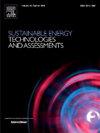涉及绿色氢气生产的100%可再生能源隔离微电网的技术经济研究
IF 7.1
2区 工程技术
Q1 ENERGY & FUELS
Sustainable Energy Technologies and Assessments
Pub Date : 2025-04-01
DOI:10.1016/j.seta.2025.104303
引用次数: 0
摘要
对化石燃料的日益依赖导致了大量温室气体排放,加剧了全球气候变化。为了解决这个问题,越来越多的人倾向于使用可再生能源,如绿色氢、光伏(PV)和风能。本研究以某大学校园为例,对三种不同的100%可再生能源供应方案进行了全面的技术经济分析:(1)光伏能源+电池+绿色氢(GH),(2)风能+绿色氢,(3)光伏能源+电池+风能+绿色氢。采用仿真模型对光伏(PV)、电池、风力涡轮机(WT)、电解槽、燃料电池(FC)和储氢罐等关键部件进行了评级优化,评估了每种方案下的净当前成本(NPC)和能源成本(COE)。结果表明,太阳能(PV)、风能和绿色氢的组合提供了最具成本效益的配置,每千瓦时的NPC为157万美元,COE为0.413美元,在经济可行性和可持续性方面优于其他配置。这些发现强调了将可再生能源与绿色氢气生产相结合的巨大潜力,为降低碳排放和支持长期环境可持续性提供了有效途径。本文章由计算机程序翻译,如有差异,请以英文原文为准。

Techno-economic study of a 100 % renewable energy-based isolated microgrid involving green hydrogen production
The increasing dependence on fossil fuels has led to significant greenhouse gas emissions, contributing to global climate change. To combat this, there is a growing tendency to use renewable energy resources (RERs), such as green hydrogen, photovoltaic (PV), and wind energies. This research provides a comprehensive techno-economic analysis on a case study of a university campus by comparing three distinct 100 % renewable energy supply scenarios: (1) PV energy with batteries combined with green hydrogen (GH), (2) wind energy with green hydrogen, and (3) PV energy, batteries, and wind energy with green hydrogen. A simulation model was employed to optimize the rating of key components, including photovoltaic (PV), batteries, wind turbine (WT), electrolyzer, fuel cell (FC), and hydrogen storage tanks, assessing the Net Present Cost (NPC) and Cost of Energy (COE) for each scenario. Results depict that the combination of solar (PV), wind, and green hydrogen offered the most cost-effective configuration, yielding a NPC of $1.57 million and a COE of $0.413 per kWh, outperforming other configurations in economic viability and sustainability. These findings emphasize the significant potential of combining renewable energy sources with green hydrogen production, offering an effective route to lower carbon emissions and supporting long-term environmental sustainability.
求助全文
通过发布文献求助,成功后即可免费获取论文全文。
去求助
来源期刊

Sustainable Energy Technologies and Assessments
Energy-Renewable Energy, Sustainability and the Environment
CiteScore
12.70
自引率
12.50%
发文量
1091
期刊介绍:
Encouraging a transition to a sustainable energy future is imperative for our world. Technologies that enable this shift in various sectors like transportation, heating, and power systems are of utmost importance. Sustainable Energy Technologies and Assessments welcomes papers focusing on a range of aspects and levels of technological advancements in energy generation and utilization. The aim is to reduce the negative environmental impact associated with energy production and consumption, spanning from laboratory experiments to real-world applications in the commercial sector.
 求助内容:
求助内容: 应助结果提醒方式:
应助结果提醒方式:


